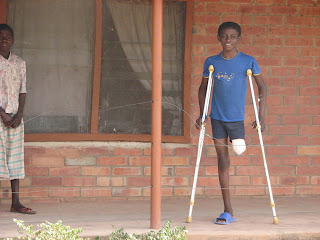
How is a biosand filter made?
With dust and sweat in 37 degrees celcius, here is a small look at what goes into making a filter.
On the right, I am sieving rocks and sand so that we have the proper size of gravel and sand to make the filter itself and also the "media" inside of the filter.
We had three different sieves made - to sort out gravel into 1/2 inch stones, 1/4 inch stones, and sand.
Although this is the "easiest" and most straight forward part - my nigerian counterparts made comments about how doing things "the canadian way" took much longer than a typical "nigerian way." They joked that "their way" is to find the shortest and fastest way possible to finish a job (whether or not it is done "the right way"), then go home as soon as possible. Joking aside, I told them we were going to do it "the right way", no matter how long it took:-)

Next, you pour a filter.
We mixed small stones, sand, and portland cement and filled our steel mold.
A steel mold can be used thousands of times if taken care of and used properly.
We let each filter set for 18-24 hours, then removed the mold, filled it with water, and let it set for another 5-7 days.
At the right, we are pouring cement in our first filter.

I demonstrated then how to work the cement into all the crevices of the filter and how to "bang out" the air that gets trapped in the cement. Air pockets will weaken the strength of the filter, so you do your best to remove them.
We banged the sides of the mold with rubber mallets until we saw fewer and fewer air bubbles coming up to the top of the fresh cement.
It often sounded like a drumming party, and I would throw a little dance in here and there to get a laugh.

Here is a "snap" (nigerian word for photo) of our very first filter! It was probably also the best one as people were diligent in their work and excited about the outcome.
The work got a bit sloppier as time went on as I tried to supervise less, and the "nigerian way" started to take over. I had to repeatedly reinforce that each step of the filter making had to be followed
exactly, not what steps they felt like doing.
A particularily frustrating day was when for some reason we could not get the mold off the filter. I demanded that the guys stop trying to remove the mold as they were on the verge of breaking it. A mold costs about $400 to have made and the cement inside is worth only about $3. They finally consented and started the process of removing the mold a different way in order to break the cement off. But as soon as I left for the market, they put the mold back on and started again trying to force it. They ended up breaking a piece of the mold, stripping the nut and part of the metal plate. Thank goodness it was a smaller piece of the mold and not the large part. It cost a few dollars to fix, but I was very upset and disappointed. The hired mason (cement worker) apologized the next day, even getting on his knees, and I told him I hope he would take this as a learning experience and not make that potentially costly mistake again.
After allowing the filter to cure, you fill it with specific levels of washed gravel and sand, place a diffuser plate on a ledge to properly difuse water into the sand, and start pouring contaminated water into it. It does not require a pump as it works by siphoning effect. The tube coming out of the nose is fed through the cement, down to the bottom of the filter. When the water level is above the curve of the tube at the top, the water is automatically pushed out. When the water level equalizes again, the water stops running.
All the parts and equipment are made from locally available supplies (although not always easy to find as home depot does not exist there) and therefore can be built anywhere in the world.
Through a simple, yet complicated process, it removes up to 98% of bacteria, 99.9% of viruses, and 100% of protozoa and worms. It requires simple maintenance that requires the user to drag their fingers through the top layer of sand. If maintained properly it can last for decades.
All for about $20. The families are required to pay for it, but the cost of the filter is a fraction of what it would cost them to treat one bout of typhoid.
It has the potential to revolutionize drinking water and eradicate water-bourne illnesses in the area. If successful in Adoka, the program can be implemented in new villages and towns.
That is the filter in a nutshell....




























